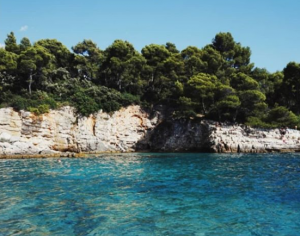
Pula, the largest city of the Istrian Peninsula, is located on the coast of the Adriatic Sea, less than 125 kilometers (75 miles) from the resort town of Trieste, Italy. It’s mild climate and unspoiled nature makes this city by the sea a favorite vacation spot for Mediterranean travellers. An active sea port and the site of many fishing and ship building concerns, Pula is the administrative center for the Istrian section of Croatia. The local growing conditions are similar to that of other Mediterranean wine regions. Pula takes full advantage of this and is the home to many working wineries.
Pula or in Italian pronounced as Pola, is considered as one of the most attractive towns in the coast of Croatia. This town located at the south of Rjeka used to be a city for some Italians until it was occupied by Yugoslavia in the year 1945. Two years after it was formally annexed. During 1945-1947, Italians who chose not to leave Pula were exiled. As of now, there are still Italians in Pula and more Pula locals can speak and understand Italian as well.
Located in a natural gulf and surrounded inland by a series of seven hills, Pula’s ports and beaches are quiet and protected.
Of course, a city can never be a part of Croatia if it does not have a beach or marina to boast. Like any other parts of Croatia, Pula has countless beaches with excellent water quality and families would really enjoy the sand, water and activities that Pula beaches cater. To fully enjoy the crystal clear and crisp water, there are recreations that you can do such as diving and windsurfing.
Pula is not unknown in classical and popular culture. Dante used the city to help describe the limits of Italian influence in his ‘Divine Comedy’. This city was also home to George Ritter Von Trapp, most well known as the patriarch of the Von Trapp Family Singers who were immortalized in the musical ‘The Sound of Music.’
Tourism Office Pula – Tourism Office Pula – Official web site
History
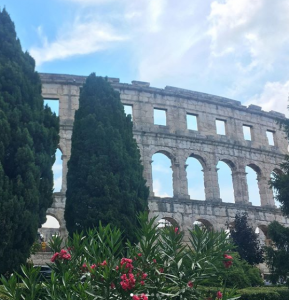
Historical structures, impressive tourist spots and other priceless man-made work of arts can be seen in Pula. The famous Pula Ampitheatre or the Arena of Pula, was built by Emperor Vespasian.. It was not built as a large Roman Ampitheatre the way it is right now. Only in the 1st Century that it was expanded, almost the same time when the Colosseum in Rome is being constructed. Currently, this 6th largest elegant Roman ampitheatre, is where gatherings, concerts and other rendezvous are held.
Pula’s history dates back to at least 1,000 BC, when the area was occupied by a tribe known as the Illiryans. This remained unchanged for hundreds of years until Roman expansion in the first century AD reached the area with a permanent settlement, which lasted for about seven hundred years, until the fall of Rome.
After that, Pula rotated through the various warring groups of the era including the Ostrogoths, the Francs, and the Venetians. It officially became part of the Venetian republic in the twelfth century.
Like much of the rest of Croatia, Pula was at one time part of the Austrio-Hungarian empire, as well as a victim of the map changing World Wars of the twentieth century.
Finding itself a part of Yugoslavia at the collapse of the Soviet Union, Pula finally became a part of the Republic of Croatia in the 1990s.
Religion is also a big part in the history of Pula. It has over fourteen churches including places of worship for Islams and Adventists. The oldest Christian site of all is the Cathedral of the Assumption of the Blessed Virgin Mary or simply called as the Pula Katedrala. It was built on the former site of a Roman temple and the original structure was seen in the 5th and 6th centuries. The cathedral has undergone numerous revonavations. In the 10th century, the expansion of the cathedral was made in order to accommodate the growing number of congregation participants. The spectacular insides and outer construction of the said Christian site is how the refurbish of the 17th century look liked.
Places to Visit Pula
The most obvious and unmistakable site is the sea itself. The gentle blue waters of the Adriatic and the warm but not sultry temperatures make Pula a popular summer vacation spot.
Various Roman ruins are found in the Pula and surrounding areas. Chief among these is ‘The Arena’, the local name for a first Century Roman Amphitheater located in the city. The Arena is one of the best preserved examples of this kind of structure and is among the largest still in existence.
For more eclectic architectural buffs, the City Arcade has been remodeled and renovated over the years and now contains examples of many centuries of architectural tradition, including Romanesque, Renaissance, and Baroque.
The Arena
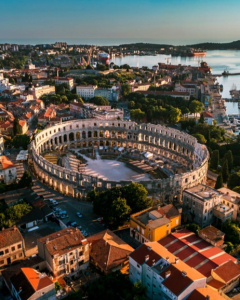
The Arena – a three storey high Roman amphitheatre. In terms of architectural conception, size and preservation, this is the most outstanding monument remaining from ancient Pula. It is the sixth largest remaining amphitheatre in the world. The four-storied Coliseum in Rome and the amphitheatres in Capua Verona, ArIes and Catania are larger. Since the amphitheatre in Pula is in better condition than the one in Verona, and higher than those in Capua, Arles and Catania, it could be said that, after the Coliseum in Rome, it is the most magnificent structure of its kind in the world.
The Arena (the word comes from the Latin “arena” meaning sand) is circular, 132.45 m x 105 m and 32.45 m in height. It is built of Istrian stone. The central part of the Arena measures 67.90 x 41.60m. The outer wall consists of foundation stones, then two storeys of arcades of 72 arches. The upper storey has 67 square windows and on top there is a cornice made of blocks of stone. At its peak it held 23,000 spectators. It was not only the scene of staged fights for the entertainment of the masses, but also a place for business, social life and entertainment. It is thought that the foundations of the first, smaller amphitheatre were laid by Emperor Augustus at the beginning of this reign. They were extended by Emperor Claudius, and the final version dates from the reign of Flavius (AD 69-81). Old legends have it that the Arena was finished and decorated by Emperor Vespasian to fulfil the wishes of his lover in Pula, Antonia Cenida. Croatian folk legends tell how the Arena was built by fairies (hence the old name “Divic-grad”, the town of the fairies) during the night, and when they heard the cock crow they left it unfinished, which is why the Arena has no roof. Some special features of the Arena are the four stone towers, and on the northwest side, a reservoir with water to supply the fountains. In AD 404 gladiator fights were banned and the arena became a cattle market. In the Middle Ages it was a source of building materials for medieval Pula and the surrounding villages. In 1583 the Great Venetian Senate decided to demolish the amphitheatre, take the stones to Venice and reconstruct it there. The demolition was prevented by the Venetian Senator Gabriele Emo, to whom a plaque was placed on the north western tower as a sign of gratitude.
The Triumphal Arch of the Sergii
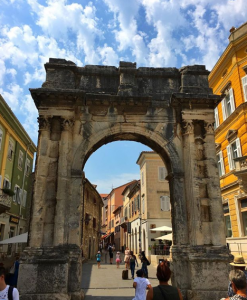
It was built between 29 and 27 BC in honour of the three Sergii: Sergius Lepidus, Gaius Lucius Sergius and Gneius Sergius who held high military and civil offices in the Empire. The arch was placed at the entrance to the main street, alongside the city gates, and it has three covered archways.
When the city gates were demolished in 1826 and 1829 the arch remained standing alone. It is decorated only on the city side. Beside the pilasters there are slender columns with Corinthian capitals; the archways the arch are decorated with winged Victories (the goddess of victory), adorned with wreaths. The frieze is decorated with putti bigae and Roman and barbarian weapons. The arch was built at the expense of Salvia Postum in memory of her close family. On the corners and in the centre there used to be statues of the three Sergii. This triumphal arch is a unique honorary and memorial structure from ancient Istria and as such has always attracted a great deal of attention from scholars and artists: sculptors, architects and painters. Sketches of the monument have been found amongst the works of Michelangelo, Sangallo and Piranesi, Cassas Adma and many others painted it.
The Temple of Augustus
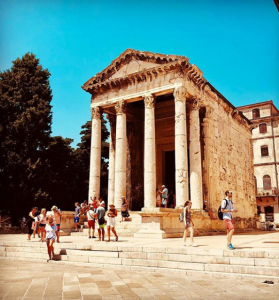
It stands on what is n the Republic Square. It is a well-balanced rectangular building, standing above a wide staircase. A huge entrance hall opens onto the square, with four columns across the front and one on each side. The walls are b of large, regularly shaped stone blocks. Over the capitals in the entrance hall there is an architrave, and above it a particularly beautiful frieze. The words of the inscription on the frieze were cast in bronze. Judging by the inscription, or rather the dedication to Emperor Augustus Patriae (Pater Patriae, the father of the fatherland), the temple was built between the year 2 BC and the death of Augustus in AD 14. Beside the Temple of Augustus, there was also a temple to Diana, but all that remains of it is the front wall, which was built into a Romanesque and Gothic palace in 1296, and was damaged in a fire in 1379. It was repaired in 1697. The palace has a wide pillared loggia and Baroque windows.
The Chastisement of Dirca Mosaic
On the courtyard side; a large floor mosaic was discovered in 1959, dating from the 2nd century AD. It is divided into 40 decorated areas. In the central area of the eastern side of the mosaics, a figural composition of the mythological cycle “the Chastisement of Dirca” is dominant. The remaining areas are decorated with rosettes, fish, dolphins and birds.
The Maria Formosa Basilica
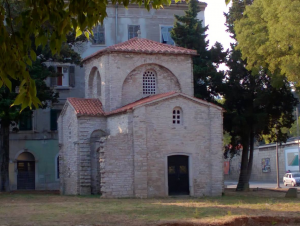
Only the southern burial chapel remains of this magnificent 6th century basilica, along with the northern wall and part of the northern rotunda. The burial chapel is in the shape of a Grecian cross and has a highly decorated polygonal exterior, with blind archways on the outer walls. Three original stone window bars still exist, the most beautiful of which is on the eastern side of the square-shaped base. The shell of the apse was decorated with a mosaic, part of which has been preserved (some fragments are in the Archaeological museum). Beneath the stucco cornice in the side chapels there are the remains of 14th century frescoes. The entire church was demolished and the pillars and mosaics were taken to Venice.
The Hercules Gate
It is the oldest remaining Roman monument in Pula. It dates from the first century BC.
The Twin Gates
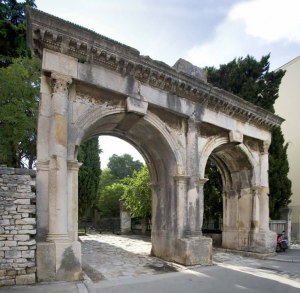
Date from the 2nd century AD. Their solid pilasters are decorated with smooth columns, above which an architrave joins together the two archways which make up the gate. The Archaeological Museum is reached through this gate. Beyond the museum, on the slopes of the hill where the Kastel (castle) is situated, there is a theatre, dating from the 2nd century AD. Its foundations are intact, as are its semi-circular orchestra and the semi-circular auditorium. The building, which was 62 m long, was entered through three huge gateways. The podium could be reached from various angles and the orchestra was reached from two sides. The auditorium was divided into two levels by an aisle.
In the Cathedral in its present form there are elements preserved of all the significant phases of its construction: the rear wall dates from the 4th century; the sanctuary with its pillars and capitals, the floor mosaic, the arched apse and the raised wall with seats for the priests date from the 5th century; the gable of the central southern entrance is 9th century; the sacristy is 13th century; the internal layout, with its huge columns is 15th century; the facade was begun in the 16th century, and the bell tower at the end of the 17th. The Renaissance portal dates from 1457 and was part of the original church of St. Michael (Sveti Mihovil) on the hill, which used to be a Benedictine Abbey.
The Orthodox Church of St. Nicholas (Sveti Nikola)
The Orthodox Church of St. Nicholas is on the northern side of the Kastel. It is a single-naved building with a polygonal apse, built around the year 600. The surface of the outer walls is broken up by lesenes (projecting vertical strips); the arch of the apse is similar to the triumphal archway in a cathedral. The columns bearing this arch have crosses carved on the capitals. The church was given over to the Orthodox immigrants from Cyprus and Naples in 1583. The wooden iconostasis is from the beginning of the 18th century and is the work of the Greek master Tomios Batas.
The Franciscan church and monastery
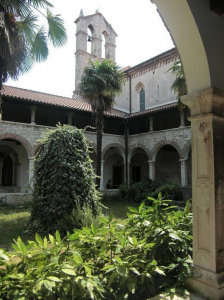
The church is triple-apsed and was built on the western slope of the Kastel in 1314. The architect paid a great deal of attention to making the interior magnificent in a simple way, but did decorate the surfaces of the outer walls. The church has a blind arcade on the cornice beneath the roof, a chevron motif on the bell tower, a magnificent Romanesque portal and a beautiful rose window on the facade. In the central apse there is a wooden polyptych from the 15th century which is one of the best examples of medieval Istrian carving. By the northern wall there is a wooden Gothic statue of the Madonna. The monastery was built in the 14th and restored in the 15th century. The Romanesque Chapel of St. John (Sveti Ivan) in the centre of the west wing of the monastery, with its Gothic portal, also contains a mosaic from the beginning of the 14th century which is in its original location.
Dante and Pula
Dante Alighieri mentioned Pula when he described the entrance into the sixth circle of Hell, Dis, where heretics burn in stone graves resembling sarcophagi. In Pula the graveyard, with ancient and early-Christian sarcophagi stretched from the city right to the Arena, and then on towards the agricultural area. These sarcophagi were later taken to Venice. Dante wrote: “For as at Arles, where soft the slow Rhone slides,/ Or as at Pola, near Quarnaro’s bay,/ That fences Italy with its washing tides,/ The ground is all uneven with the array,/ On every hand, of countless sepulchres,” (Hell IX, lines 112-116; trans. Dorothy L. Sayers).
James Joyce in Pula
Joyce came to Pula frrom Trieste on 28th or 29th October 1904 as a twenty-two year old. He came with his common-law wife, Nora Joseph Barnacle, and found work as a teacher of English in the Berlitz school in Pula, a branch of the one in Trieste. His first flat was in what is today Laginjina Street (no. 2/II), and he moved to his second home (7 Medulinska street) in December, because the first flat had no heating. At that time Nora gave birth to their child. In letters sent from Pula he wrote that he was working hard: teaching English, learning German, translating and writing. He felt that Pula was “a God-forsaken place” and called it the “sailors’Siberia”. Five months later he was forced to leave Pula, following a spy scandal uncovered by Austrian counter-espionage agents. His sxmajor crime was associating with Italians. In his novel “Portrait of the Artist as a Young Man” there is a notable sentence; “a day of multi-coloured clouds, born from the sea”, which critics have attributed to Pula.
Museums and Collections
The Istrian Archaeological Museum
It was founded in 1901/2 as the City Museum and in 1925 became the Istrian Regional Museum. In 1930 it became the Istrian Archaeological Museum. On the ground floor, in the corridors, there is a display of stone monuments from ancient times (i.e. from the 1st to the 4th centuries), then from the Roman era to the early Middle Ages (4th-9th centuries). On the first floor there is a prehistoric collection including finds from the Romuald grotto and the Sandalj caves and stone monuments from Nezakcij. On the second floor is an ancient (Roman) collection, where abundant finds from Istria, and especially from Pula, are arranged chronologically. There are decorative carvings, Roman building materials, ceramic lamps, bronze and iron objects, items connected with arts and crafts, pharmaceutical and cosmetic utensils, and a particularly beautiful collection of glass objects. The later Roman and early medieval exhibition on the second floor is dedicated to the later classical period and the time of the migration of the nations (the 5th and 6th centuries). These are mostly new finds. There is an important collection of items from graves from the 7th to the 12th centuries from sites near Motovun, Buzet and Zminj (these were graves of Slavs).
Ancient sculpture (The Temple of Augustus, Forum).
This collection of stone monuments from the Pula area was founded in 1802. In 1815 when the temple was restored, the collection was extended. The present exhibition dates from 1968 and includes the most beautiful examples of Roman sculpture, especially portraits. Apart from stone sculptures, there are also examples of bronze work. Especially impressive are: a large stone torso which was part of a statue of the Emperor and was discovered on the site of the great Roman theatre; a statue of the Emperor with a kneeling slave; the head of Atis from Pula, etc.
Wine and Olive Production in Istria in Ancient Times (the Arena, in the underground gallery)
This collection was founded in 1880 and was expanded up to 1925 as a collection of stone monuments, but from 1969 it has been an exhibition of wine and olive production in the Roman era. There is a display of the development of wine and olive production in Istria using tables and maps, and also a typological overview of seals and amphorae, copies of old maps, a reconstructed wine-press and an original olive mill.
The Medieval Collection of Stone Monuments and the Exhibition of Copies of Frescoes in Istria (the Franciscan Monastery, 5, Uspon Balda Lupetine street).
This exhibition hall was arranged. for stone monuments in 1963. In the atrium and in the eastern wing of the monastery there are some stone fragments from the Middle Ages which are also chronologically related. The Chapel of St. John (Sveti Ivan) is particularly worth seeing, especially because of its mosaics in situ. The exhibition of copies of Istrian frescoes shows frescoes from the 9th to the 17th century, and includes the following sections: the Romanesque era, Gothic frescoes, and the Renaissance.
The Historical Museum of Istria (Povijesni muzej Istre, Uspon Muzeja 14).
This museum is in a Venetian fortress which was built between 1629 and 1638 using plans drawn up by A. Devill, in the shape of a star with four bastions and two entrances. The museum shows the development of the labour movement in the 19th century, the Italian occupation of Istria and the Fascist dictatorship, and the resistance of the Istrian people. Most exhibits relate to the People’s War of Liberation in Istria (the Second World War); some show the riots that occurred during the Anglo-American occupation of Pula and the diplomatic struggle to unite Istria and Pula with Croatia.
Places to Eat Pula
Foods are necessities, is abundant in restaurants that serves different dishes that would suit the preference of your taste buds. From spicy to exotic, raw or grilled foods, it has a wide variety of delicacies to choose from. In Pula alone, there are already five five-star restaurants that you can go to.
Colorful local restaurants are located throughout the Pula area. As in many of the Adriatic cities, the range of cuisine includes Italian, Greek, and French in addition to traditional Croatian and Hungarian fare.
Chinese food is also popular in many of the Adriatic resort towns. Most Pula eateries will feature the many local wines grown and bottled in the surrounding areas.
Getting There & Away Pula
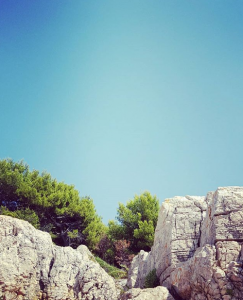
Being quite separated from the rest of Croatia, Pula accommodates aerial flights from neighbouring places such as Zagreb (with daily flights) and European cities like Dublin, London, Manchester, Oslo, Zurich, Edinburgh and Amsterdam. However, if you want to go to Pula coming from Italy, you can take a bus ride coming from Venice. There are only two bus schedules, 11 A.M. and 1:45 P.M. It would have a short stop first at Istria, and then the final unloading of passengers is at Pula. Tickets can be bought at the A.T.V.O. bus office located at the bus station in Venice.
Pula has it’s own airport, providing service to all of the Istrian peninsula. Flights from England, Italy, and other European cities are available. Airlines servicing the facility include Ryanair, the largest budget airline in Europe, which has recently announced service to Pula from Dublin.
For those preferring to land in larger airports, Zagreb, the capital of Croatia, and Trieste, located up the Adriatic coast in Italy, are common choices.
Unique to Pula
As one of the oldest established cities in the region, history is everywhere. Roman ruins, historic churches, and samples classic Croatian, Hungarian and Austrian architecture are here in abundance.
The interested visitor can go even further back into history than the Roman times. Further back into natural history, to be exact, by following several sets of dinosaur tracks fossilized and preserved near this ancient sea shore.
Facts & Figures about Pula
Phone Prefix – 052
Postcode – 52100
Population – 58,594
Previous Name – Pola – Italian
Pula weather at the moment is: 4 ºC
Tourist Office Pula
Address: Forum 3
Phone: +385 52 212 987
E-mail: [email protected]
The tourist office has maps of Pula and surrounding areas available.
